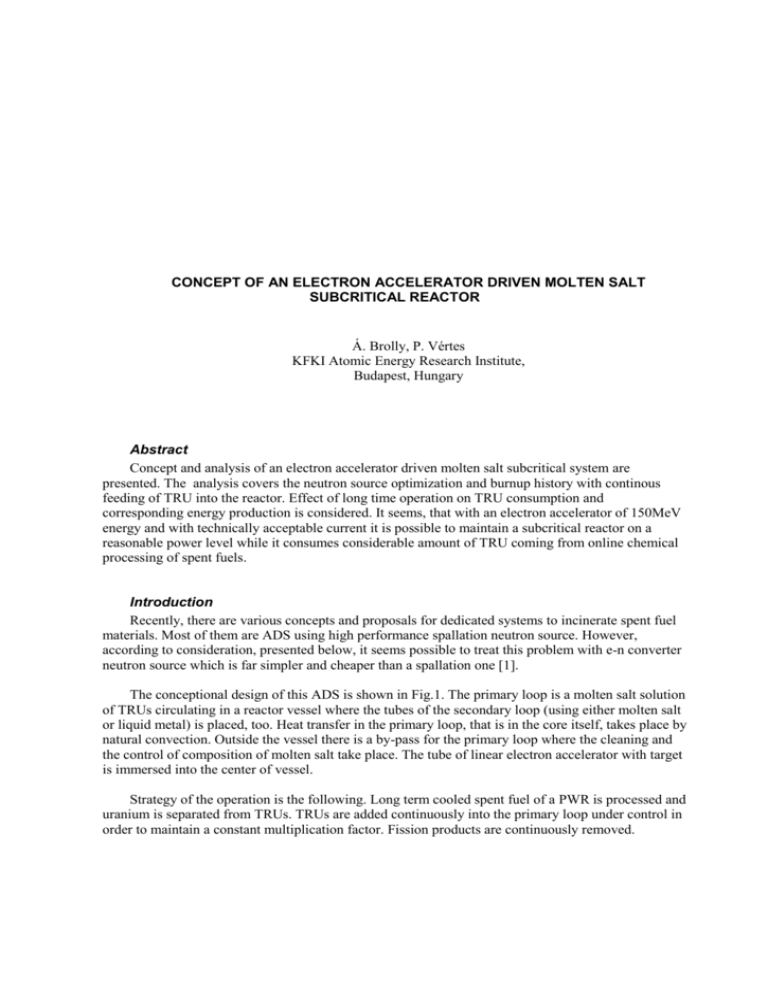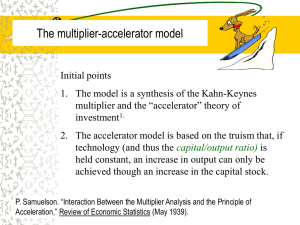concept of an electron accelerator driven molten salt subcritical reactor
advertisement

CONCEPT OF AN ELECTRON ACCELERATOR DRIVEN MOLTEN SALT SUBCRITICAL REACTOR Á. Brolly, P. Vértes KFKI Atomic Energy Research Institute, Budapest, Hungary Abstract Concept and analysis of an electron accelerator driven molten salt subcritical system are presented. The analysis covers the neutron source optimization and burnup history with continous feeding of TRU into the reactor. Effect of long time operation on TRU consumption and corresponding energy production is considered. It seems, that with an electron accelerator of 150MeV energy and with technically acceptable current it is possible to maintain a subcritical reactor on a reasonable power level while it consumes considerable amount of TRU coming from online chemical processing of spent fuels. Introduction Recently, there are various concepts and proposals for dedicated systems to incinerate spent fuel materials. Most of them are ADS using high performance spallation neutron source. However, according to consideration, presented below, it seems possible to treat this problem with e-n converter neutron source which is far simpler and cheaper than a spallation one [1]. The conceptional design of this ADS is shown in Fig.1. The primary loop is a molten salt solution of TRUs circulating in a reactor vessel where the tubes of the secondary loop (using either molten salt or liquid metal) is placed, too. Heat transfer in the primary loop, that is in the core itself, takes place by natural convection. Outside the vessel there is a by-pass for the primary loop where the cleaning and the control of composition of molten salt take place. The tube of linear electron accelerator with target is immersed into the center of vessel. Strategy of the operation is the following. Long term cooled spent fuel of a PWR is processed and uranium is separated from TRUs. TRUs are added continuously into the primary loop under control in order to maintain a constant multiplication factor. Fission products are continuously removed. Our design consideration presently covers the target optimization and burn-up with spent fuel consumption together with energy production. The optimal dimension and placing of target Details about the target optimization can be found in [2]. Target optimization means finding the maximum of neutron production inside the target and maximum of neutron leakage to the core at given electron energy and target shape and material, as well. Optimization is accomplished in two steps by means of the MCNPX [3] code. The first step is the size and the second is the source placing optimization. As a result authors obtained for liquid lead and 150MeV electron beam an optimal cylindrical target of 30cm diam. and minimum 20cm length. Assuming an electron beam current 10mA, a neutron source strength about 2.9x1015 n/s is gained [2] Further, if the subcritical core of ADS is 250cm high then the optimal arrangement is a 100cm lead after 150cm vacuum tube of accelerator. Step-wise burnup calculation with step-wise fuel supply Burnup is calculated step-by-step. Starting from fresh fuel composition 80-group flux is calculated with TORT SN code [4]. This flux is averaged over the core volume and the fuel is burned by means of point burn-up code TIBSO [5] over a time step. Length of time-step is chosen in accordance with the source strength.. The higher the source strength is, the shorter the time step. So, a new fuel composition is calculated to which an amount of fresh fuel is added. This is calculated in the following way: the number of fissions (fbas) is calculated with the flux obtained in the first step that is with the flux averaged over the core of fresh composition. In each step the number of fissions (fis) is calculated again for the actual flux and core composition. The number fissions (fcont) for the fresh fuel material (coming from the chemical separation) is also calculated with the flux obtained in this step. Then, we add fresh fuel in proportion: fbas fis fcont If this number is less than zero then nothing is added assuming that we are not able to get out fuel material from the system. The “proportion” should be understood in the following way. In fresh fuel the relative amount of TRUs are fixed as they come from the spent fuel inventory. We are operating with amount of TRUs relative to that of Pu239 (further it is called normed inventory). The TRUs inventory to be added is coming from the normed inventory times the above factor. As it can be seen from the numerical calculations given below, the multiplication factor step-by step will oscillate around a value. At the beginning this oscillation may be quite large, particularly if the system is near to critical. However, when the burn-up proceeds, this oscillation becomes smaller though not monotonic. Towards the end of compaign the multiplication factor is almost constant. The source strength i.e. the accelerator current is changed inversely with the multiplication factor and the length of time step is changed proportionaly with it. (Thus, the product of time step and source strength should remain constant) In this way, disregarding this fluctuation we get a stable multiplication factor and energy production but no equilibrium in composition – at least within reasonable time. Model calculations The procedure outlined above is performed for a simplified system. We disregard the inhomogenity caused by the secondary loop inmersed in the core and take a system with the following dimensions and composition. Target and accelerator tube: diameter: 30cm, height of target: 80 cm, Core: diameter: 340cm, height: 250cm Vessel (iron): 15cm thick. Normed composition of TRU as coming from a 40 MWday/kg burned and 20 year cooled PWR spent fuel is isotope 93-Np-237 94-Pu-238 94-Pu-239 94-Pu-240 94-Pu-241 94-Pu-242 94-Pu-244 95-Am-241 95-Am-242m 95-Am-243 96-Cm-243 96-Cm-244 96-Cm-245 96-Cm-246 atom*1024/cm3 1.054E-01 4.238E-02 1.000E+00 5.728E-01 1.088E-01 1.380E-01 1.702E-05 1.813E-01 1.398E-04 4.489E-02 7.133E-05 8.682E-03 9.577E-04 1.245E-04 gramm/cm3 4.142E+01 1.673E+01 3.964E+02 2.280E+02 4.348E+01 5.536E+01 6.889E-03 7.245E+01 5.609E-02 1.809E+01 2.875E-02 3.513E+00 3.891E-01 5.079E-02 Salt composition: isot atom*102 4 3 ope /cm 33.14E-7 Li-6 36.927E-3 Li-7 46.07E-3 Be-9 9-F3.59E-2 19 111.623E-2 Na-23 Source strength: 2.4x1015 n/s (8.27 mA accelerator current), initial burn-up step: one day. Two systems are considered. In the 1st system the accelerator tube&target is surrounded by the core itself. In the 2nd one a 10 cm thick graphite ring is placed between the accelerator tube&target and core. The starting fuel amount in the 1st system: 1.7*1020 atom Pu-239/cm3, and in the 2nd system: 1.6*1020 atom Pu-239/cm3. These correspond to 1.29mol% and 1.22mol% of TRU, respectively. These values are within the solubility limit of TRUs in the salt which is 1.4mol% [6]. 1800 steps are done. Energy and mass balance The calculated operational features of the system is summerized in the table below. Criticality factor Energy produced (Gwday) Operation time (day) Energy consumed by accelerator (Gwday) Consumed spent fuel TRU (ton), without initial loading Initial loaded spent fuel TRU (ton) Remaining TRU (ton) 1st system 0.9796 233.82 1872.57 2.23 2nd system 0.9818 244.92 1863.59 2.20 7.68 8.30 2.78 2.57 3.31 3.25 Composition of initial loaded and remaining TRUs after 1800 steps are shown in Fig. 2. In the Fig.3 the time dependence of multiplication factors of the two systems are shown. In Fig. 4-5 the amount of added TRU in function of steps are given. The normed fluxes after 1800 steps are shown in Fig.6. Conclusions The concept of a relatively simple ADS is proposed in this paper. It produces energy from spent fuel, while a considerable amount of this TRU is incinerated. An e-n converter neutron source plays an important role in balancing the system. A multiplication factor about 50 is an adequate value ensuring a stable and effective operation. Two systems have been considered. The 2nd one which includes a graphite ring around the tube&target system has somewhat better performance. The proposed design may be a safe and economical tool for diminishing the burden of nuclear waste material while it is utilized for considerable energy production. However, it does not eliminate all problems with spent fuels residuals. Due to the soft neutron spectrum, the remaining TRU in core after a long time operation contains many higher actinides which may have risk comparable to that of original spent fuel [7]. References [1] Bernardin, B. et. al.: 2001. A Prototype Sub-Critical Reactor Driven by Electron Accelerator. Proceedings of 4th International Conference on Accelerator Driven Transmutation Technologies and Applications (ADTTA 2001). USA. [2] Á. Brolly, P. Vértes: Annals of Nuclear Energy, 31 585. (2004) [3] L.S. Waters, ed.: MCNPXTM User’s Manual, Version 2.3.0, LA-UR-02-2627, April 2002 [4] W. A. Rhoades, D.B. Simpson: The TORT Three-dimensional Discrete Ordinates Neutron/Photon Transport Code, ORNL/TM-13221, 1997 [5] P. Vértes: Multinudal Treatment of Production, Decay and Spreading of Radioactive Isotopes, Nuclear Technology, Vol.128. p.124, 1999. [6] V. Ignatiev et al.: Transport properties of molten-salt reactor fuel mixtures, Proceedings of the Seventh Information Exchange Meeting on Actinde and Fission Product Partitioning and Transmutation, Jeju, Korea, 14-16 October 2002. [7] Á. Brolly, P. Vértes: Concept of a small-scale accelerator drivensystem for nuclear waste transmutation Part 2. Investigation of burnup. Submitted to Annals of Nuclear Energy Fig. 2 Relative compositions 0.50 0.45 0.40 initial final 1st system final 2nd system 0.35 0.30 0.25 0.20 0.15 0.10 0.05 cm 24 5 cm 24 6 cm 24 3 cm 24 4 24 2m am 24 3 24 2 am am 24 1 am pu 24 2 pu 24 1 pu 24 0 pu 23 9 pu 23 8 np 23 7 0.00 isotope Fig. 3. Multiplication factors 80 75 70 1st system 2nd system 65 60 55 50 step 1777 1703 1629 1555 1481 1407 1333 1259 1185 1111 1037 963 889 815 741 667 593 519 445 371 297 223 149 75 1 45 Fig.4 Added TRU for the 1st system 7.0E-06 5.0E-06 4.0E-06 3.0E-06 2.0E-06 1.0E-06 step 1749 1673 1597 1521 1445 1369 1293 1217 1141 1065 989 913 837 761 685 609 533 457 381 305 229 153 1 0.0E+00 77 atom*10^24/cm^3 6.0E-06 1. 39 5. E-0 04 4 6. E+0 14 0 4. E+0 54 1 1. E+0 23 2 2. E+0 31 3 4. E+0 31 3 8. E+0 05 3 1. E+0 50 3 2. E+0 61 4 6. E+0 74 4 2. E+0 35 4 5. E+0 64 5 1. E+0 05 5 2. E+0 87 6 1. E+0 00 6 E+ 07 value of normed flux 1 4.5E-02 4.0E-02 3.5E-02 3.0E-02 2.5E-02 2.0E-02 1.5E-02 1.0E-02 5.0E-03 0.0E+00 Energy step Fig.6. Flux integrated over the core volume 1st system 2nd system 1777 1703 1629 1555 1481 1407 1333 1259 1185 1111 1037 963 889 815 741 667 593 519 445 371 297 223 149 75 atom*10^24/cm^3 Fig.5 Added TRU for 2nd system 9.0E-06 8.0E-06 7.0E-06 6.0E-06 5.0E-06 4.0E-06 3.0E-06 2.0E-06 1.0E-06 0.0E+00








